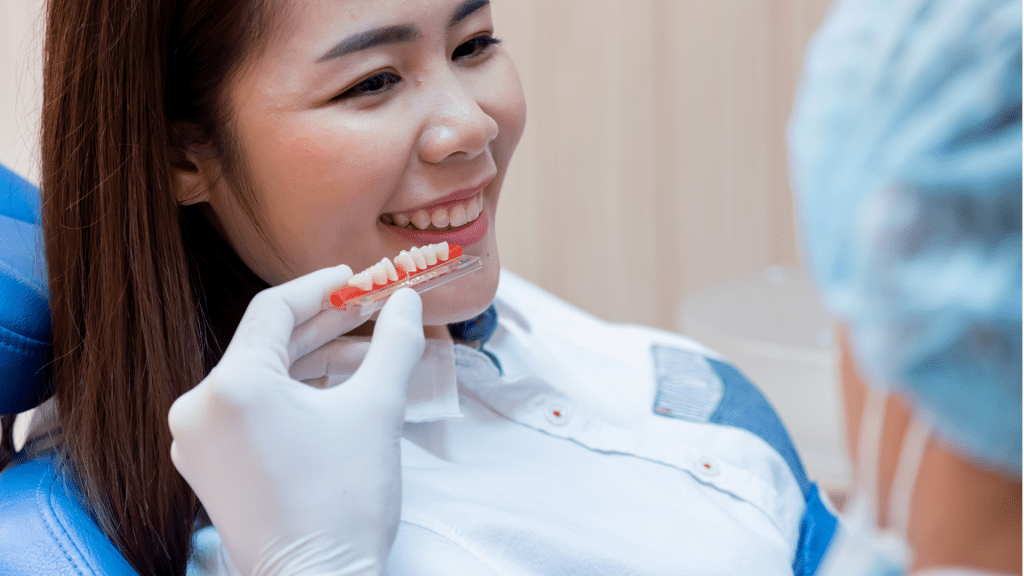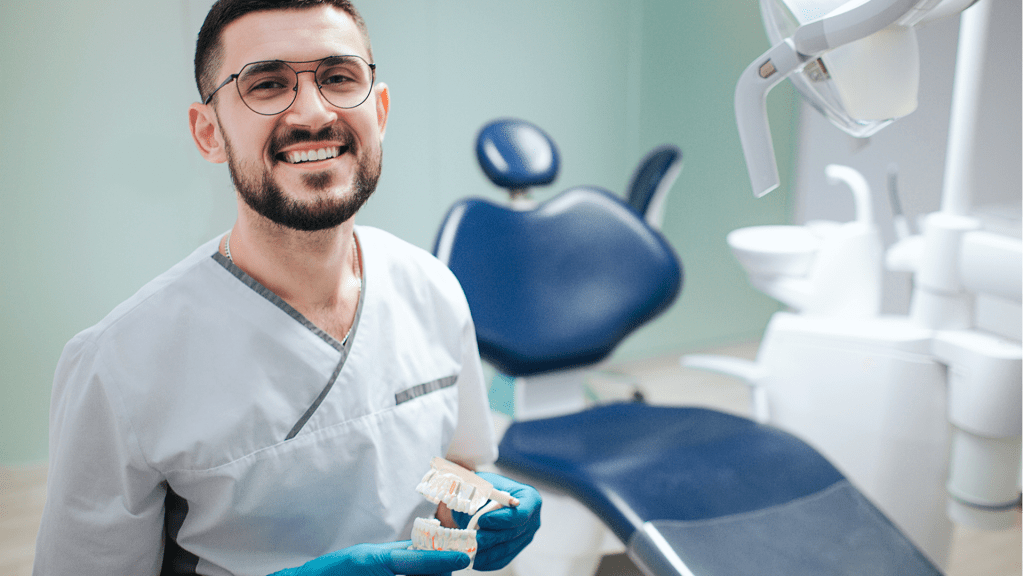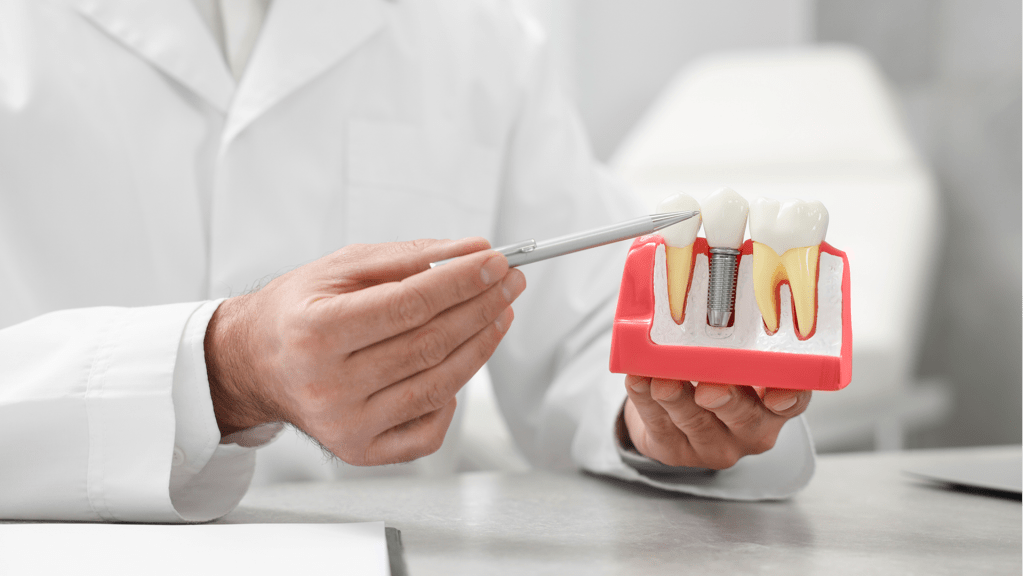- Fairfax: 703.226.2222
- Reston: 703.391.2222
- Set Up An Appointment
August, 2025
Replacing All Your Teeth: Real Reasons and Relief
For many patients, the decision to remove all their teeth isn’t taken lightly and it often comes after years of frustration, discomfort, and declining oral health. Whether it’s constant dental pain, multiple cracked or failing teeth, or the progression of advanced gum disease, the path to full-mouth extraction can be a difficult one. But for some, it’s also the first real step toward relief.

If you’ve been living with chronic dental issues, you’re not alone. Many patients reach a point where repeated treatments no longer offer long-term solutions. In these cases, continuing to “patch” the problem becomes exhausting emotionally, physically, and financially. Full-mouth extraction and replacement can offer a clean slate, bringing closure to years of stress and a chance to rebuild your smile with strength, comfort, and confidence.
Importantly, choosing to remove all your teeth isn’t giving up. It’s not failure. It’s a proactive decision, one that prioritizes your quality of life, your health, and your future. For many patients, it’s the turning point toward freedom from pain, easier maintenance, and the ability to finally smile, eat, and speak without worry.
Your Full Arch Replacement Paths
Once you’ve made the decision to remove all your teeth, the next question is: What comes next? Fortunately, today’s replacement options offer more stability, comfort, and realism than ever before. Whether you’re looking for something simple and affordable or a solution that feels nearly identical to your natural teeth, there’s a path that can work for you.
Here’s a breakdown of the most common full-arch replacement options, each with unique benefits and considerations:
Traditional Full Dentures
Traditional dentures are the most economical and fastest solution for full arch replacement. These removable appliances sit on top of your gums and are custom-fitted to your mouth. While they’ve come a long way in terms of appearance, they do require nightly removal, regular cleaning, and the use of adhesives to stay in place.
Pros: Affordable, non-surgical, fast turnaround
Considerations: May feel loose, requires daily maintenance, less support for jawbone over time
Implant-Retained (Snap-In) Dentures
For a more secure and bone-friendly option, implant-retained dentures, sometimes called “snap-in dentures,” are anchored by 2 to 4 dental implants. These dentures are still removable, but they attach firmly to the implants for greater stability while eating or speaking.
Pros: Improved fit, no adhesives, helps preserve bone
Considerations: Requires minor surgery, still removed for cleaning
Fixed All-on-X Implant Bridges
All-on-X implant bridges offer a permanent, non-removable solution. Using 4 to 8 dental implants, these bridges are securely fixed in place and function much like natural teeth. You won’t remove them at night or worry about slipping. For many, this is the gold standard in full arch teeth replacement offering the best in comfort, aesthetics, and long-term stability.
Pros: Most natural feel, fixed in place, easy to maintain
Considerations: Higher initial investment, requires surgery and healing time
Same-Day Implants
With advances in technology, some patients may be candidates for same-day implant treatment where extractions, implant placement, and a temporary arch all happen in one appointment. This approach provides an immediate aesthetic solution and begins the healing process without delay.
Pros: Immediate results, fewer visits, fast confidence boost
Considerations: Not ideal for every case, requires detailed evaluation and planning
Each of these options can be life-changing in different ways. Your dentist will work closely with you to determine which treatment path aligns best with your oral health, lifestyle, goals, and budget.
Pros & Cons of Each Route
Every full-mouth restoration option comes with its own advantages and trade-offs. The best choice depends on your goals whether you’re looking for something fast and budget-friendly, or you want the most natural-feeling, long-lasting solution.
Here’s how traditional dentures, implant-retained dentures, and fixed implant bridges compare across the key factors that matter most:
Upfront Cost vs. Long-Term Value
Implants cost more up front, especially with full-arch bridges, but they’re built to last 10–20 years or more. Many patients find the long-term value, both functional and financial, is worth the investment.
Dentures have the lowest initial cost, making them an accessible solution for many patients. However, they may require more frequent adjustments or replacements over time.
Functionality: Eating, Speaking & Comfort
Implants excel in everyday use. They stay firmly in place, restore up to 90% of natural bite force, and allow for easier speech and eating.
Dentures may move slightly, especially if adhesives weaken. They restore less bite strength and can take time to adjust to when speaking or chewing tougher foods.
Bone Health & Facial Support
Implants help stimulate the jawbone, preventing the bone shrinkage that often follows tooth loss.
Dentures don’t provide this stimulation. Without roots or implants, the jawbone can gradually resorb, which may change the shape of your face and affect future treatment options.
Daily Care & Maintenance
Implants are brushed and flossed just like natural teeth. No adhesives, no soaking; just a normal hygiene routine.
Dentures must be removed nightly and cleaned with special solutions. They also need to be stored safely and may occasionally require relining.
Healing & Treatment Timeline
Implants usually require a healing period of 2–6 months, allowing the bone to fuse with the implant. However, same-day implant options may be available depending on your health and bone condition.
Dentures can often be fitted quickly, sometimes even on the same day as extractions (as “immediate dentures”), providing a fast cosmetic solution.
Choosing the right path isn’t about one-size-fits-all. It’s about finding what works for you. Whether your priority is speed, affordability, longevity, or comfort, your dentist can guide you through the decision with care and clarity.
Step-by-Step Treatment Journey

The process to replace all your teeth begins with a thorough evaluation. During this visit, your dentist will perform a complete exam and take 3D imaging (CBCT) to assess the condition of your bone, gums, and overall oral health. This allows your care team to build a fully customized treatment plan, one that takes into account your goals, anatomy, lifestyle, and budget.
When it’s time for extractions, the focus is on comfort and safety. Sedation is often available to help you feel relaxed during the procedure. If needed, bone grafting or sinus lifts can be performed during the same visit to strengthen the jaw and prepare it for implant placement. These steps help create the best possible foundation for your new smile.
Once your mouth is ready, implants are placed with precision and care. Depending on your needs, your dentist will determine the ideal number and positioning of implants, often between four and eight per arch, to ensure long-term stability and function.
In many cases, a temporary arch is provided the same day or shortly after implant placement. This allows you to leave the office with a full smile while your full mouth heals and the implants integrate with your bone. These transitional teeth are designed for aesthetics and light function during the healing phase.
After full healing, typically a few months later, your final teeth are crafted and placed. These permanent restorations are custom-designed to look and feel natural, giving you the comfort, function, and confidence you’ve been waiting for.
Throughout every phase, your dental team is there to guide you answering questions, managing your care, and helping you move forward with clarity and peace of mind.
Managing Pain, Healing & Emotional Impact

It’s natural to have questions or even some anxiety about what recovery will feel like after full-mouth extraction and implant placement. But for many patients, the experience is far less difficult than expected. In fact, the discomfort following treatment is often easier to manage than the chronic pain or dental sensitivity they’ve been living with for years.
Thanks to modern techniques and personalized care, post-treatment pain is typically mild to moderate and can be managed with anti-inflammatories or prescription medications when needed. Many patients are surprised by how quickly they start feeling better, especially once the source of their ongoing dental problems has been addressed.
For added comfort, sedation options are available during the procedure itself, ranging from local anesthesia to conscious sedation or general anesthesia, depending on your medical needs and preferences. Your care team will walk you through these choices ahead of time to ensure a smooth, stress-free experience.
Emotional healing is just as important as physical recovery. Losing your natural teeth, even by choice, can bring up unexpected feelings. Many patients find it helpful to track their progress with pre- and post-treatment photos, which offer a clear reminder of how far they’ve come. Support from your dental team, friends, or loved ones can also make a big difference during this transitional time.
To promote proper healing, your dentist will provide detailed post-op instructions. This typically includes using cold compresses to reduce swelling, sticking to soft foods for the first few days, and avoiding habits that might interfere with healing (like smoking or using straws). Monitoring for dry sockets and attending follow-up visits will help ensure your recovery stays on track.
Healing is a process, but one that brings you closer every day to a smile that feels like a fresh start.
Choosing the Right Option for You
When it comes to full-mouth restoration, there’s no one-size-fits-all answer. The best solution depends on your unique health needs, lifestyle, and personal goals. A thoughtful consultation with your dental team will help determine the most appropriate path, one that balances long-term success with what matters most to you.
Your current oral and overall health play a major role. Factors like bone density, medical history, and your ability to maintain daily oral hygiene will influence whether you’re a good candidate for implants or if another option is more suitable. If bone loss is present, your dentist may recommend grafting or other preparatory steps to ensure a stable outcome.
It’s also important to consider your lifestyle and expectations. Do you want a permanent solution that feels as close to natural teeth as possible? Or would you prefer the flexibility and affordability of removable options? Healing time, maintenance routines, and cosmetic preferences all come into play and your comfort with each option matters just as much as the clinical recommendations.
Finally, don’t underestimate the importance of choosing an experienced provider. Look for a dental team with advanced training in implants, oral surgery, or prosthodontics, as well as a strong track record of successful outcomes. High-quality practices often track success rates with implant procedures showing 90–95% success over five years when performed and maintained properly.
Making the right choice starts with trusted guidance, clear information, and a team that puts your well-being first.
Life with a New Smile
Once your final teeth are in place, daily life changes in all the best ways. You’ll smile more confidently, eat with ease, and speak without worrying about shifting or discomfort. Still, it’s normal to go through a brief adjustment period as you settle into your new smile.
In the first few weeks, you’ll likely start with soft foods and gradually reintroduce a wider range of meals as your comfort and bite strength improve. Some patients notice minor speech changes at first, but these usually resolve quickly as your tongue and muscles adapt to the new teeth.
Caring for your restoration is straightforward but depends on which option you choose. If you have an implant-supported arch, you’ll brush and floss much like natural teeth, along with attending regular professional cleanings. With traditional or snap-in dentures, nightly soaking and thorough brushing are essential to keep them fresh and bacteria-free.
Routine dental checkups remain important no matter which path you choose. Semi-annual visits allow your dentist to check the fit and condition of your restoration, monitor your gum and bone health, and catch potential issues like peri-implantitis early.
With consistent care and professional follow-up, your new smile can stay strong, functional, and beautiful for many years to come.
Quick Decision Checklist
If you’re wondering whether full-mouth tooth replacement is the right step, ask yourself these key questions:
- Are you dealing with chronic dental pain or recurring issues that make daily life uncomfortable?
- Do you want a secure, high-functioning smile that lets you chew, speak, and laugh without worry?
- Are you prepared to invest in a solution that provides long-term health, stability, and confidence?
- Do you have access to experienced dental specialists who focus on full-mouth extractions and implant restorations?
- Are you comfortable with the recovery process and ongoing care required to protect your results?
If most of these resonate with you, a consultation could be the first step toward a lasting, life-changing solution.
Confidently Take Your Next Step
Choosing full-mouth tooth replacement is a life-changing decision, one you deserve to make with confidence. At Optimal Dental Center, we make the process clear, comfortable, and fully tailored to you.
During your consultation, you’ll receive a thorough exam with on-site 3D imaging, a personalized treatment plan outlining every option, and access to comfortable sedation dentistry to ensure a stress-free experience. Our team also provides transparent pricing and flexible financing, so you can focus on your health and results without financial surprises.
Regain your comfort, function, and confidence. Schedule your transformation consultation today and take the first step toward a smile that truly lasts.
